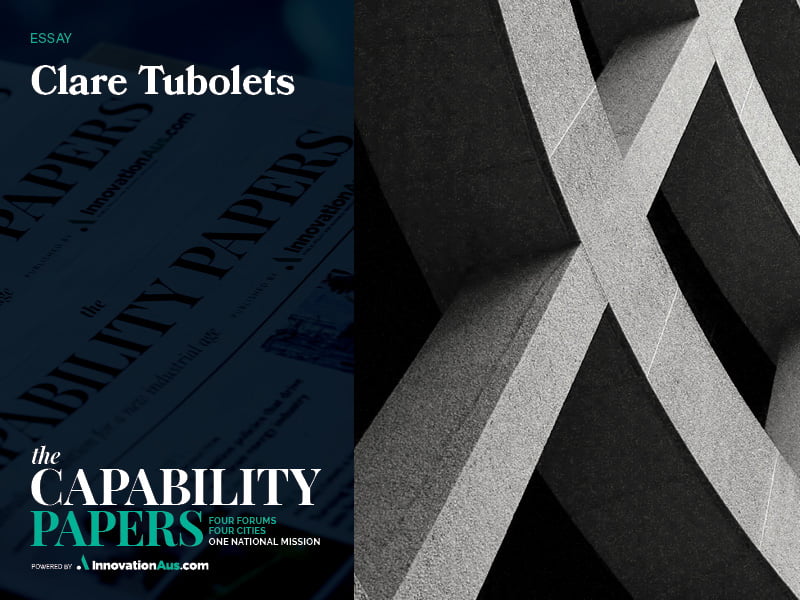There is no net zero without a dramatic reduction in emissions from concrete production. While Australia has exceptional capabilities in this area, the challenge will be in creating the environment and framework in which they can be realised.
Right now, the Victorian Government’s Office of Projects Victoria (OPV) is in a partnership with The University of Queensland and RMIT University to investigate and implement new applications of domestic and industrial waste materials in the concrete construction industry.
With the support of SmartCrete CRC, the stakeholders are advancing a pre-mix concrete design developed in conjunction with Sustainability Victoria into a ‘green’ concrete that utilises waste, such as recycled plastic flakes and fines, rubber fines, crusher dust fines and recycled concrete aggregates, as alternative aggregate.

At the same time and perhaps most importantly, they will be testing supplementary and alternative ‘cementitious’ materials that are intended to replace, in part at least, the most carbon-intensive part of the concrete production process, which is the manufacture of Ordinary Portland Cement (or simply ordinary cement).
The drastic reduction and eventual elimination of concrete’s carbon emissions is arguably the most important step along the way to net zero, both locally and globally.
Concrete is ubiquitous, versatile, affordable, durable, strong and recyclable. It’s also the second most-used material in the world, after water.
However, mostly due to the production of the cement that binds the other ingredients, concrete has a serious CO2 emissions problem.
Around 8 per cent of global CO2 emissions come from concrete and, without research and innovative solutions such as those being explored by the OPV partnership, that footprint is set to grow.
The growth of Australia’s economy and population, combined with demand for affordable and climate-resilient buildings and infrastructure, sees the production of concrete forecast to increase by as much as 40 per cent by 2050. That is a statistic that will be replicated in numerous other countries.
Our net zero economy relies on concrete, but in its current form and with traditional methods of production, concrete will derail net zero goals. But it doesn’t have to.
Australia’s role in greening concrete
Enormous levels of knowledge have been developed in Australia and globally around low carbon concrete using supplementary cementitious materials, as well as finding better, more sustainable ways to design and build that allow for the use of less concrete and for the removal and reuse of demountable, modular concrete segments in buildings and other constructions.
In Australia specifically, we have strong capability in the concrete sector. Our concrete and cement industry has reduced CO2 emissions by 25 per cent since 2000.
In some areas, we lead the world. This is particularly true in terms of the knowledge behind geopolymer concrete, which uses industrial waste such as fly ash and slag in place of cement. This solves a waste challenge and a carbon emissions issue all at once.
Most of the primary research into zero-cement concretes has been conducted in Australia, meaning we’re no stranger to groundbreaking innovation and leadership.
The challenge lies with concrete innovation being accepted and adopted at scale within the construction and engineering ecosystem.
A roadmap to carbon zero
In 2021, the Cement Industry Federation, Cement Concrete & Aggregates Australia and SmartCrete CRC issued the independent report Decarbonisation Pathways for the Australian Cement and Concrete Sector, capturing the entire Australian cement and concrete value chain.
It outlined eight pathways for the industry to lower its CO2 emissions and to decarbonise by 2050. They were:
- Zero emission electricity and transport
- Innovation through design and construction
- Continue to further innovate concrete
- Use of supplementary cementitious materials in concrete
- New CO2-efficient cements
- Use alternative fuels and green hydrogen
- Account for concrete to take up CO2
- Capturing remaining CO2.
Points 3, 4, 5 and 7 are all directly related to concrete and are areas in which key stakeholders from industry, research and government are being identified to drive the identification and implementation of solutions.
This has resulted in collaborative research partnerships, like the Office of Projects Victoria example, that are leading to real, measurable and essential outcomes.
Another example is Boral. In 2020 the construction materials company entered into a partnership with University of Technology Sydney (UTS) to accelerate product innovation including the research, development and commercialisation of low carbon concrete.
As part of that partnership, the UTS Boral Centre for Sustainable Building was established to aid research and build capabilities.
Situated at UTS Tech Lab, the multidisciplinary facility connects Boral staff with some of the country’s leading concrete experts to research and innovate sustainable building technologies.
And yet, a widespread hesitancy around adopting innovative concrete products still exists.
Geopolymer and alkali-activated binder concretes, for instance, both cement-free, are backed by research and have been utilised in various real-world applications, including in Australian buildings and infrastructure.
Despite enviable access to raw and low-carbon materials, only Queensland construction materials producer Wagner has ventured down the geopolymer concrete route by developing Earth Friendly Concrete. Unfortunately, much of Wagner’s market for such a product is currently offshore.
Setting a net zero framework
Many of the required parts are already in place to take Australia on the journey to zero-emission concrete, and to enjoy the economic benefits of leadership in what will be a vital solution globally.
Of course, there are still many critical unknowns, but we have great capabilities from a research perspective to help address those.
These include Macquarie University Smart Green Cities Hub, RMIT University TREMS, University of Queensland Sustainable Infrastructure Centre, UTS Tech Lab, Swinburne University Smart Structures Laboratory and more.
There are also new standards released in May 2023 – a Technical Specification that outlines requirements and provide guidance for the design and construction of geopolymer concrete and alkali-activated binder concrete building structures.
It is hoped such standards will encourage engineers and construction businesses to bring such products into their designs more often.
Without a fresh attitude toward change in design, without relevant government guidelines and regulations, and without leadership at all levels to demonstrate confidence in new products and processes, our various concrete capabilities will remain unused and their economic advantages unexploited.
However, if we leverage industry, government and research collaboration more effectively, we can achieve our vital emissions reduction targets.
Meeting our net zero goals is absolutely possible. But in the world of concrete, it will require further efforts and significant regulatory, technological, structural and collaboration across the entire value chain.
Clare Tubolets is Chief Executive Officer at SmartCrete CRC, the Cooperative Research Centre helping to transition Australia’s concrete ecosystem to reach net zero. Prior to joining SmartCrete CRC, Ms Tubolets was Chief Operating Officer at Food Agility CRC which was focused on the food and agriculture sector.







